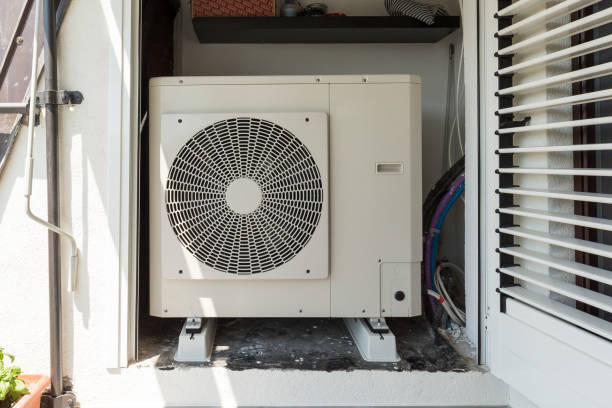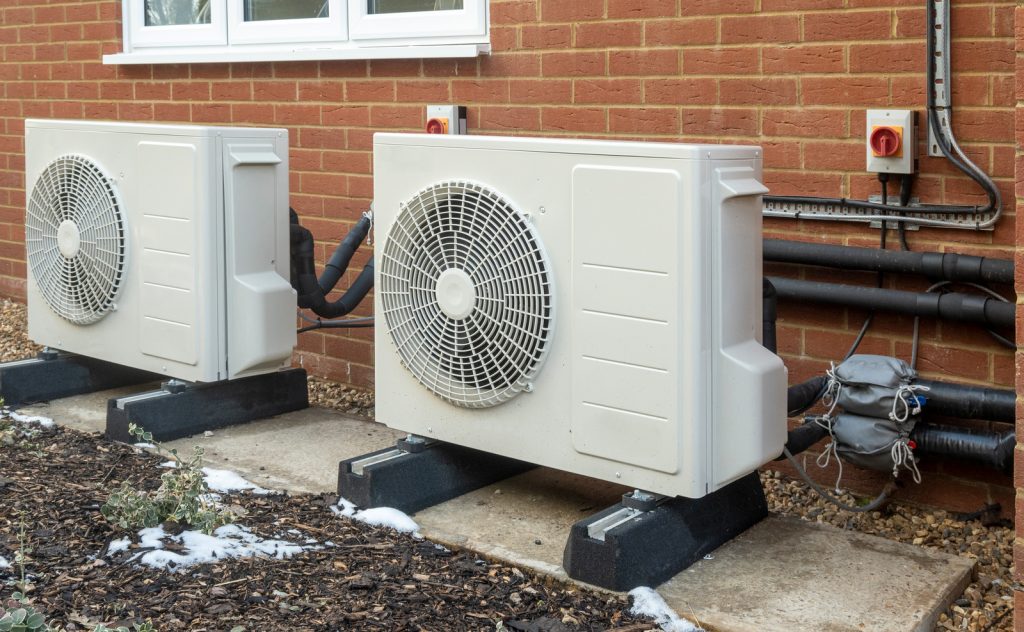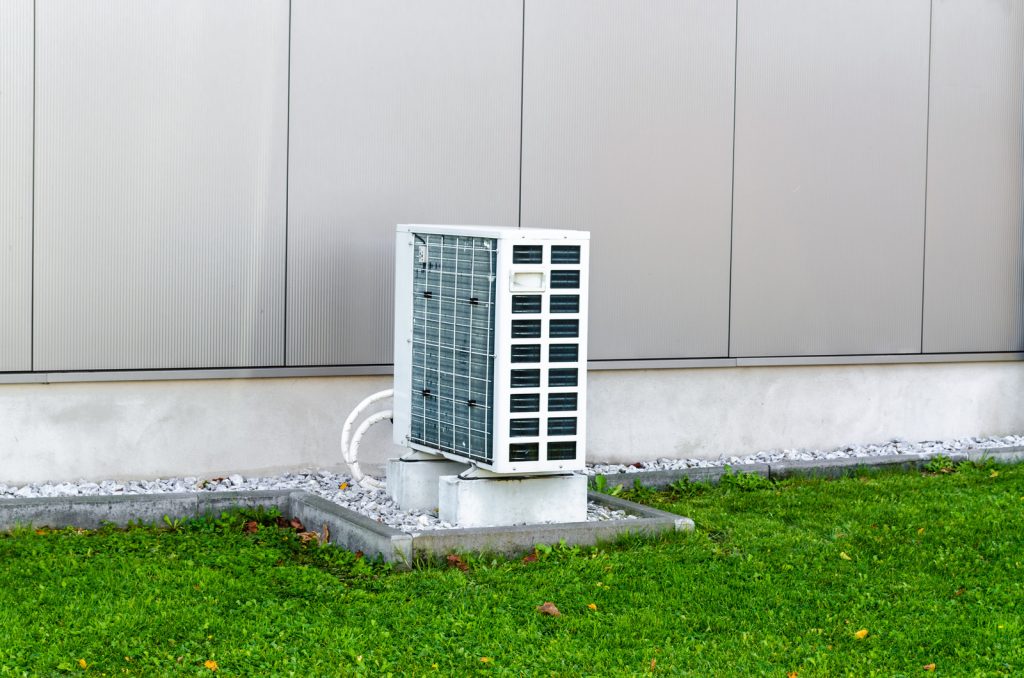
Air source heat pumps are becoming increasingly popular as an alternative to traditional heating systems. They are a type of renewable energy technology that can provide heating and cooling for homes and businesses. But how do air source heat pumps work?
Put simply, air source heat pumps work by absorbing heat from the outside air and using it to heat buildings. They use a refrigerant to extract heat from the air, which is then compressed to increase its temperature. The heat is then transferred to the heating system of the building, either through a radiator or underfloor heating system. In the summer, the process can be reversed to provide cooling.
There are two main types of air source heat pumps: air-to-air and air-to-water. Air-to-air heat pumps provide warm air that is circulated around the building using fans. Air-to-water heat pumps transfer the heat to a water-based system, which can then be used to heat radiators or underfloor heating systems. Both types of heat pump can be used for heating and cooling, making them a versatile and efficient choice for many homes and businesses.
What is an Air Source Heat Pump?
An air source heat pump (ASHP) is a type of heat pump that can absorb heat from the outside air and transfer it into a building to provide space heating and/or hot water. It works by using a refrigerant that absorbs heat from the outside air and then transfers it to a heat exchanger inside the building. The heat exchanger then releases the heat into the building’s heating system.
ASHPs are generally more efficient than traditional heating systems because they do not generate heat themselves. Instead, they move heat from one place to another. This means that they can deliver up to three times more heat energy to a home than the electrical energy they consume.
ASHPs can be used for both heating and cooling purposes. They are particularly effective in moderate climates, where temperatures do not usually fall below freezing. In colder climates, they may need to be supplemented with additional heating systems to ensure that the building remains warm enough.
How do Air Source Heat Pumps Work?

An air source heat pump is a renewable energy technology that works by extracting heat from the air outside and transferring it into a building to provide space heating and hot water. This technology can also work in reverse to provide cooling during the summer months.
The Basic Mechanism of Air Source Heat Pumps
The basic mechanism of air source heat pumps involves a refrigerant that is circulated between an outdoor unit and an indoor unit. The outdoor unit contains a coil of piping that absorbs heat from the air, which is then transferred to the indoor unit via the refrigerant. The indoor unit then uses this heat to warm the air inside the building.
The refrigerant in the outdoor unit is able to absorb heat from the air even when the temperature outside is as low as -15°C. This means that air source heat pumps can still provide efficient heating even during cold winter months.
The Different Types of Air Source Heat Pumps
There are two main types of air source heat pumps: air-to-water and air-to-air. Air-to-water heat pumps are designed to provide heating and hot water for a building, while air-to-air heat pumps are designed to provide heating and cooling.
There are also different configurations of air source heat pumps, such as split systems and packaged systems. Split systems have the outdoor unit and indoor unit separated, while packaged systems have both units combined into one.
The Efficiency of Air Source Heat Pumps
Air source heat pumps are highly efficient, with some models able to provide up to 4 units of heat for every 1 unit of electricity used. This means that they can provide significant cost savings on energy bills compared to traditional heating systems.
It is important to note, however, that the efficiency of air source heat pumps can be affected by factors such as the size of the building, the insulation, and the temperature outside. It is therefore important to ensure that the system is correctly sized and installed by a qualified professional.
The Benefits of Using Air Source Heat Pumps
Air source heat pumps are becoming increasingly popular due to their numerous benefits. Here are some of the advantages of using air source heat pumps:
- Energy Efficiency: Air source heat pumps are highly energy-efficient and can deliver up to three times more heat energy to a home than the electrical energy it consumes. This is possible because a heat pump transfers heat rather than converting it from a fuel like combustion heating systems. According to the Department of Energy, “air-source heat pumps have been used for many years in nearly all parts of the country, but they have not been used in areas that experience extended periods of subfreezing temperatures.”
- Cost Savings: Air source heat pumps can provide significant cost savings compared to traditional heating systems. According to Isoenergy, “the lack of ground disruption when installing an air source heat pump is a major factor in the reduced overall price. Another benefit from installing an air source heat pump is the current Renewable Heat Incentive (RHI), which helps pay for the initial cost of the heat pump over time.”
- Year-Round Use: Air source heat pumps can be used all year round for both heating and cooling. According to Energy Star, “your heat pump is more energy-efficient than a furnace or boiler, even during winter. If you have both, you should use your heat pump year-round.”
- Zoned Heating and Cooling: Air source heat pumps can heat or cool specific rooms or zones in a home to a certain temperature. This is particularly useful if there are persistently colder or warmer areas in a home that need to be regulated. According to EnergySage, “another benefit of using air source heat pumps is that you can heat or cool a specific room or zone in your home to a certain temperature.”
- Environmentally Friendly: Air source heat pumps are environmentally friendly as they use renewable energy from the air to heat and cool a home. According to Consumer Reports, “heat pumps don’t emit any harmful gases or pollutants, and they don’t rely on fossil fuels.”
Overall, air source heat pumps offer numerous benefits, from energy efficiency to cost savings and environmental friendliness. As such, they are an increasingly popular choice for homeowners looking for an efficient and sustainable heating and cooling solution.

Disadvantages of Air Source Heat Pumps
While air source heat pumps have many benefits, they also have some disadvantages to consider before making a decision.
Higher Upfront Cost
One of the biggest disadvantages of air source heat pumps is their higher upfront cost compared to other heating systems. This is because they require specialized installation and equipment. However, over time, the energy savings can offset the initial cost.
Less Efficient in Cold Weather
Another disadvantage of air source heat pumps is that they become less efficient in colder weather. This is because they extract heat from the outside air, and as the temperature drops, there is less heat available to extract. As a result, the heat pump has to work harder to maintain the desired temperature, which can increase the electricity usage and decrease efficiency.
Noisy Operation
Some air source heat pumps can be noisy during operation, especially when the outdoor unit is located close to windows or outdoor living spaces. However, newer models are designed to operate more quietly, so it is important to research and choose a model that fits your needs.
May Not Be Suitable for All Homes
Finally, air source heat pumps may not be suitable for all homes. For example, homes with high heating demands or larger homes may require additional units to provide adequate heating. Additionally, homes in extremely cold climates may not benefit from air source heat pumps as much as homes in milder climates.
While air source heat pumps have some disadvantages to consider, they remain a popular and efficient heating option for many homes.
The Installation and Maintenance of Air Source Heat Pumps
Choosing the Right Size of Air Source Heat Pump
Before installing an air source heat pump, it is important to determine the right size for your home. The size of the heat pump will depend on various factors such as the size of your home, the number of rooms, and the level of insulation.
A heat pump that is too small will struggle to heat your home, while a heat pump that is too large will be inefficient and costly. To determine the right size of air source heat pump, it is recommended to consult with a professional installer who can conduct a heat loss calculation. This calculation takes into account factors such as the insulation of your home, the number of windows, and the orientation of your property.
The Installation Process of Air Source Heat Pumps
The installation process for air source heat pumps will depend on the type of heat pump you are installing and whether it is ducted or ductless. In general, the installation process involves the following steps:
- Site survey and assessment: The installer will assess your property and determine the best location for the heat pump.
- Indoor unit installation: If you are installing a ductless system, the indoor unit will be mounted on the wall. If you are installing a ducted system, the indoor unit will be installed in the attic or a closet.
- Outdoor unit installation: The outdoor unit will be installed on a concrete pad or mounted on a wall.
- Piping and electrical connections: The installer will connect the indoor and outdoor units with refrigerant piping and electrical cables.
- Commissioning and testing: The installer will test the system to ensure it is working properly and make any necessary adjustments.
The Maintenance of Air Source Heat Pumps
To ensure that your air source heat pump operates efficiently and lasts for many years, it is important to perform regular maintenance. This includes:
- Cleaning or replacing air filters every 3-6 months
- Cleaning the outdoor unit and removing any debris or vegetation
- Checking the refrigerant levels and topping up if necessary
- Checking the electrical connections and tightening any loose connections
It is recommended to have your air source heat pump serviced by a professional installer at least once a year to ensure that it is working at its best. Regular maintenance can also help to prevent breakdowns and prolong the lifespan of your heat pump.
